THE CURIOUS CASE OF MIRAVAL’S GRAPES
Note: Marc Perrin, partner with Jolie and Pitt to produce and distribute Miraval rosé, provided answers (after publication) to some of these curiosities. To find out what he said, please see my updated post (10/15/13).
Back in the spring, readers may recall all the hoopla over the release of Brad and Angelina’s first rosé from their newly acquired chateau in Provence. The Modern Trobadors hopped on the crowded band wagon with a post about the celebrity status of Château Miraval long before the glam couple took up residence and I included a synopsis of our tasting notes wherein we gave their rose, called simply “Miraval,” an enthusiastic thumbs-up.
I reviewed the history of the château —where vineyards were first planted in the 15th century—and, fast-forward to 2008, how the famous couple, while hovering above the property in a helicopter, fell in love with it, leased it for three years, and bought it in 2011. I recounted how, for matters of wine, they turned to the well-known Perrin family from Châteauneuf-du-Pape. As the now oft-repeated story goes, mutual friends made the introduction and the threesome bonded over bottles of wine and a common interest in organic viticulture.
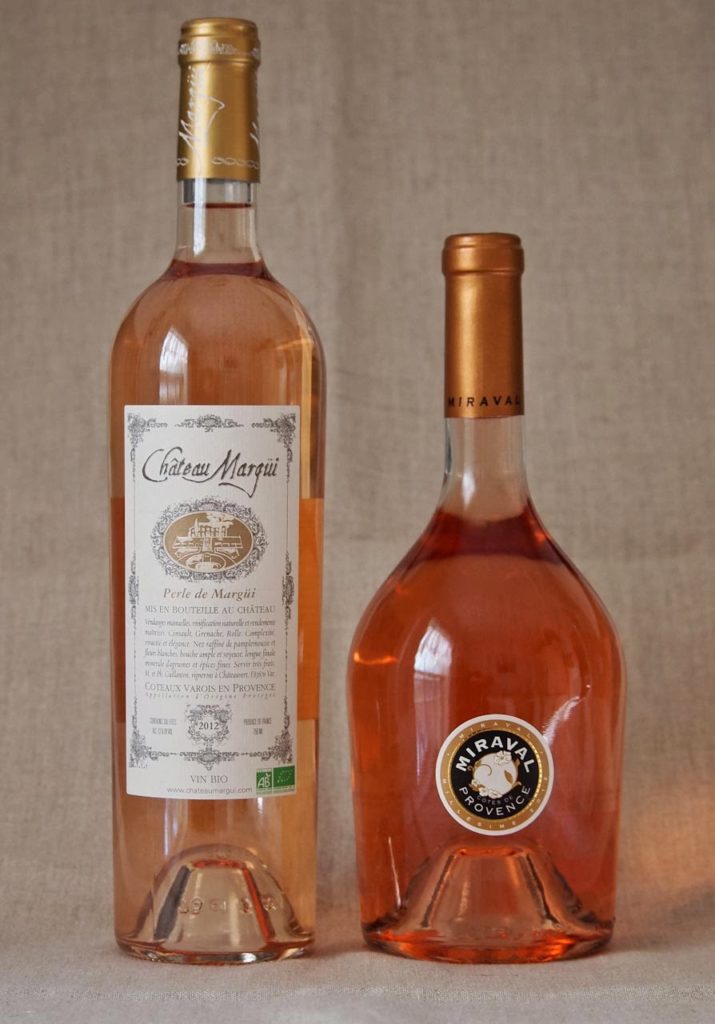
Miraval alongside a bottle of “Perle de Margüi,” a winery that neighbors Château Miraval. Photo by W.T. Manfull
Several weeks after writing that post, something about the Miraval wine story hit me. It was in the middle of another rosé tasting that included Miraval alongside a bottle of “Perle de Margüi,” the wonderful rosé from Château Margüi, a winery that neighbors Château Miraval in the Var department of Provence. (More on this tasting in an upcoming post.)
As I was admiring the lovely Château Margüi label, I noticed the two tiny green logos squeezed into the lower right-hand corner. The logos confirm that the grapes used to make the wine in said bottle are organic. The “AB” logo (meaning “Agriculture Biologique”) is the French certification that the product has at least 95% organic materials and that it was produced within the European Union. The other logo is the EU certification that at least 95% of the ingredients are organic. Lest one misses the stamps, the words “VIN BIO” were spelled out at the bottom of this label.
But wait, I thought to myself…. Château Miraval has long prided itself on being biologique. I had written in my post—and many articles in the main stream press had also written—that this rose was “organic.” Online wine stores continue to promote Miraval rosé as being “organic.”
But, curiously, nowhere on the Miraval bottle was there any indication that this rosé —first production under the team of Jolie, Pitt, and Perrin—had been made with organic grapes. No tiny green “stamps.” No “VIN BIO.”
I checked the Château Miraval website which, one would think, would be the most authoritative source. And, while there is not much information on that website, it does clearly confirm that “The estate is cultivated 100% organically, without using herbicides, pesticides, or chemicals that can enter the vine and affect the evolution of the fruit.”
According to the website of the Provence Wine Council (in French, the Conseil Interprofessionnel des Vins de Provence, which is the organization of Provence wine producers and related trading companies), “Château Miraval is recognized as one of Provence’s highest-quality organic wine producers” and “All production is from grapes grown organically in the Commune of Correns, the first organic village of France.” Correns has been “100% organic” since 1995.
The popular predecessor of Miraval rosé, called “Pink Floyd,” was produced from organically-grown grapes for years. Why would Jolie, Pitt, and Perrin break with tradition?
I thought back to all the articles I had read in preparation for writing the TMT post in May (2013) and I couldn’t recall seeing any reference to this much anticipated 2012 Miraval rosé being anything other than biologique. According to an article in Bloomberg by Elin McCoy (February 14, 2013), “Another bonding factor [between the two parties] was the fact that the estate is organic.” Marc Perrin, whose family is said to have “pioneered organic viticulture in 1950,” reportedly said to the Bloomberg writer, “For us, organic is the only way to grow grapes.” Indeed, the Famille Perrin website states that the Perrin family “is the leading organic wine grower of the Southern Rhône Valley….”
So, what’s going on? Is the Miraval rosé made from organically cultivated grapes…or not?
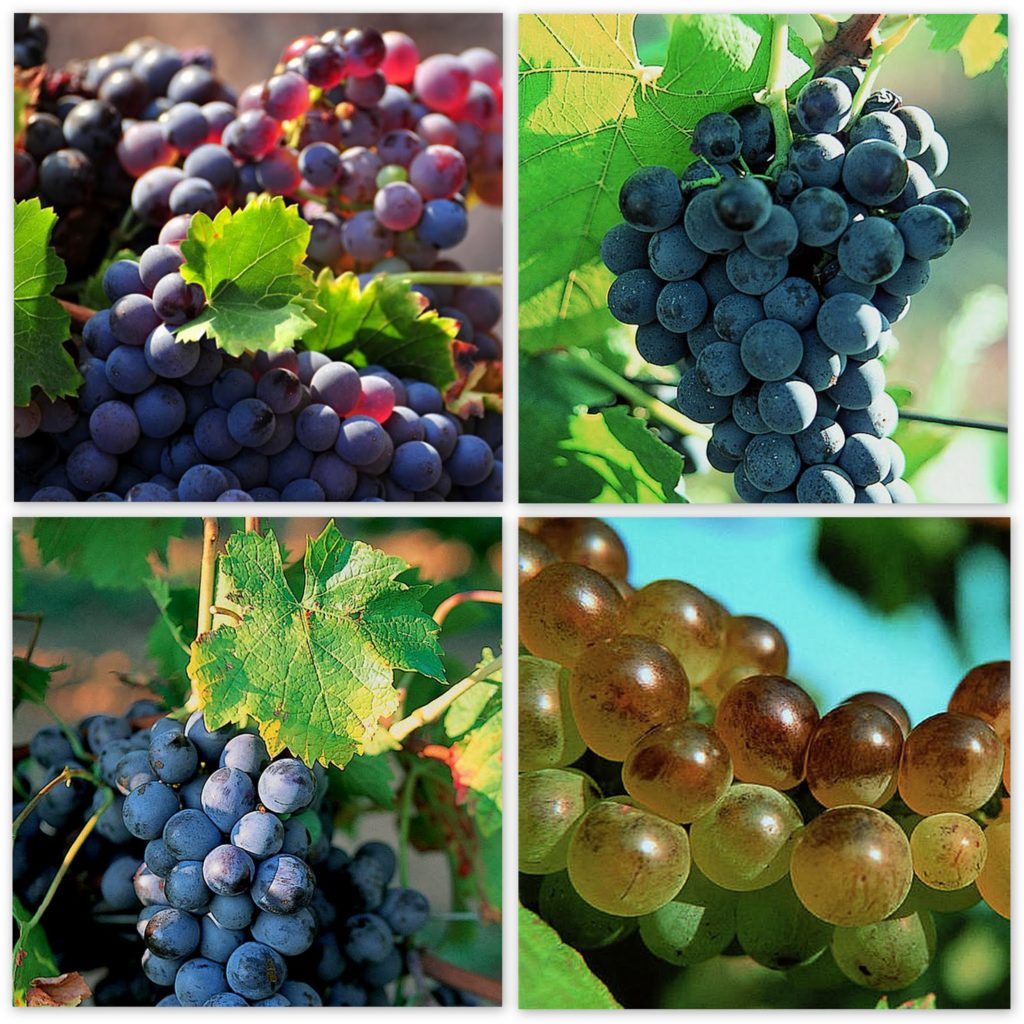
Grape Varieties (Clockwise from top left – Grenache, Syrah, Rolle, Cinsault) Photo: Francois Millo/CIVP
A little more sleuthing on the internet dug up just one article, in French, that shed some light on the bio status of the new rose. In an interview in August (2013) with Bernard Burstchy for Le Figaro Vin, Marc Perrin said that they use organic farming on all of their properties, but that nothing is indicated on the label (my translation). Hmmm…so why bother with those silly little logos that detract from a pretty label?
We would telephone Château Miraval and see if we could get to the bottom of this curious case.
“Pas de tout,” was what the woman who answered the telephone at Château Miraval said. In English, “Nothing at all,” she said, confirming that she could not provide any information. All inquiries of any sort, she said, were to be directed to Famille Perrin in the Vaucluse. We did manage to wrangle out of her a confirmation that the tasting room was no longer open (which, we learned later, had closed several years earlier).
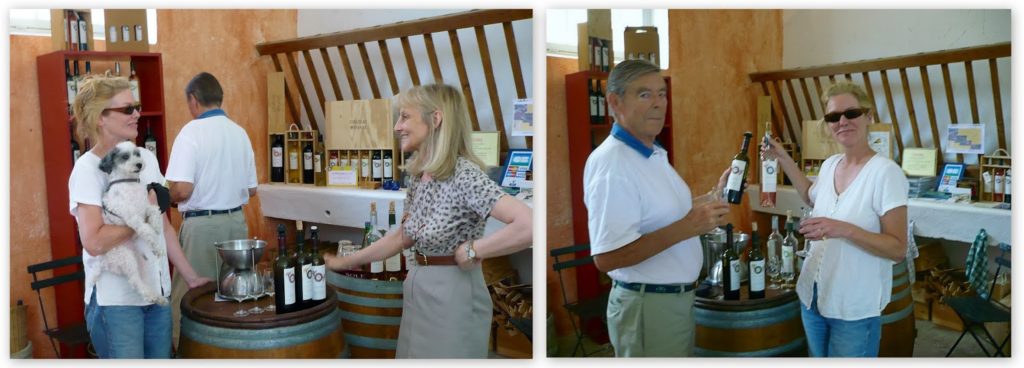
The tasting room at Château Miraval in 2007, prior to the Brad and Angelina acquisition. Photo by Pamela J. O’Neill
Following directions, we called Famille Perrin but were informed that we needed to pose all questions in writing. So, we composed an email and sent it to the email address provided by the officious French woman who answered the Famille Perrin telephone and, for good measure (or was it for kicks and giggles?), we sent one off to Marc Perrin. Guess what? Yep, no response.
Tant pis. In the meantime, friends who live in the Var, the department in which some of the best rosés in the world are produced, were able to talk with a knowledgeable source (who shall remain unnamed) who said that Miraval rosé was indeed not bio because some of the grapes—no one with whom we spoke with could say what percentage although apparently more than five percent—were not grown organically. Apparently, this source said, Jolie-Pitt & Perrin could not amass enough organically grown grapes to produce the quantity of wine they expected to sell.
Okay, ce n’est pas grave—sales of the first release of the famous couple’s rosé would surely soar….and they did, selling out very quickly—but why not be transparent about this issue? They would have sold out quickly anyway.
Now, curious minds are left to wonder where the grapes did come from, a question made more intriguing when we learned from the same Var source that none of the Miraval rosé was produced at the Château. A closer look at the Miraval bottle suggests, if not confirms, the area where the production took place, but only the most discerning label-reader would recognize this…and only one who knows the zip codes of Provence could fully decipher it.
The third line on the back label reads “MIS EN BOUTEILLE PAR JOLIE-PITT & PERRIN,” which means “bottled by Jolie, Pitt and Perrin.” The fourth line reads “A F-84100,” which means the wine was bottled in the city of Orange, in the neighboring department of the Vaucluse, some 180 kilometers (112 miles) away from Château Miraval. Famille Perrin’s main operation is located in Orange.
Wow. Although it was clear that Famille Perrin had been brought onto the team and would share profits 50-50, it was not clear that the rose would be made some place other than the chateau. The website states, “Since 2012, the owners of Château Miraval have partnered with Famille Perrin to help with the viticulture, winemaking and wine distribution.” It doesn’t say that the wine would be made off the premises.
The website goes on to say, “With investments in the latest winemaking technology and a passion for excellence at every stage of production, Château Miraval is dedicated to delivering top quality wines to international acclaim.” Were their investments in this technology for equipment in the Vaucluse operation?
Did any part of the vinification process take place at Château Miraval? How were the grapes—or juice—transported to the operation in the Vaucluse? And why?
Perhaps, as our unnamed source suggested, it may have been that the renovations in the cave were not completed in time to make the 2012 vintage at Château Miraval. If this is the case, we wonder if the 2013 vintage of Miraval rosé will be “mis en bouteille au chateau” when, surely the cave upgrade will have been finished. Our source didn’t know (and, of course, those that do know weren’t answering the telephone or responding to emails).
Perhaps the imminent release of the Château white wines will cast some light on the future production of rosé. According to the Château Miraval website, the Cotes de Provence white was slated for release in August 2013 and the Coteaux Varois white was scheduled for release in September 2013. (The château has vineyards in both appellations.) In the Le Vigaro Vin interview, Perrin said that the Coteaux Varois white would be released first (in September) and the Cotes de Provence white would come later.
No one we spoke with—in France or in the States—had seen either white wine although the proprietor of a high-end wine shop, La Cave de Cotignac, in the Var village of Cotignac, said that he had expected to receive the Coteaux Varois en Provence blanc last week.Where were the whites produced?
Where are the grapes from? And for goodness sakes, are they biologique…as earlier vintages had been? There used to be three whites, two of which were aged in oak barrels; the current website suggests just two whites would be released and we were told by our sources that none would be aged in oak barrels, as the Terre Blanche and Lady Jane cuvées had been. But, this is mostly hearsay, not a peep from Jolie-Pitt & Perrin.
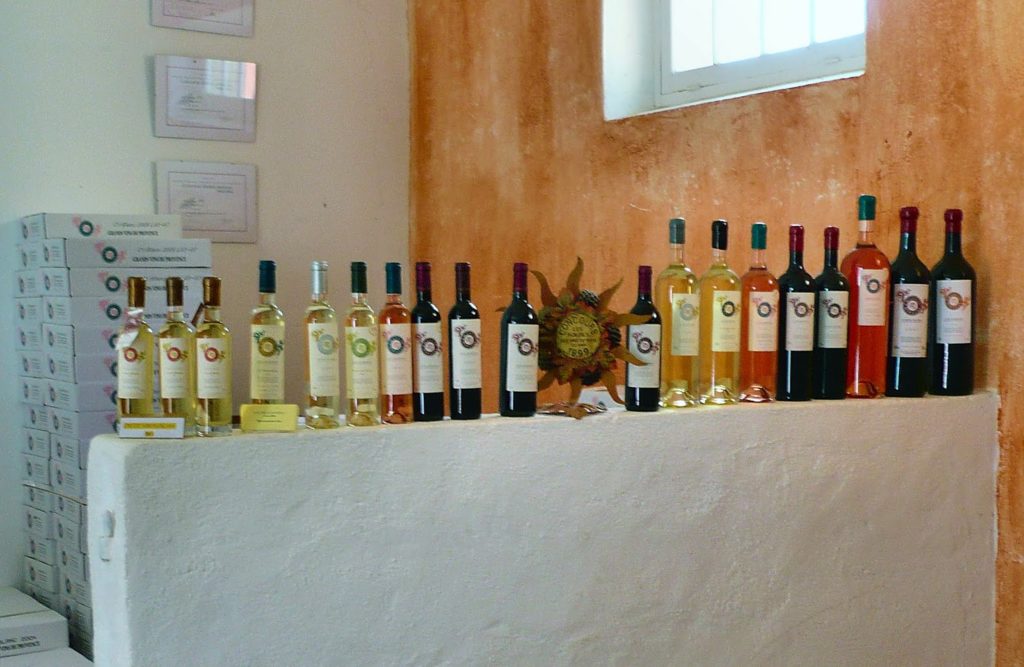
The tasting room at Château Miraval in 2007, prior to the Brad and Angelina acquisition. Photo by Pamela J. O’Neill
According to the Château Miraval website, two reds will be released. One was expected in September 2013 and another in March 2014. We wait with bated breath, same questions in tow.
As we endeavored to unravel the curious case of the Miraval rose grapes, we veered into other areas and ended up with more questions than answers. Geesh, I don’t think we found any answers (except that the tasting room is definitely closed—we didn’t think to ask if Miraval wines are available for tasting in Orange).
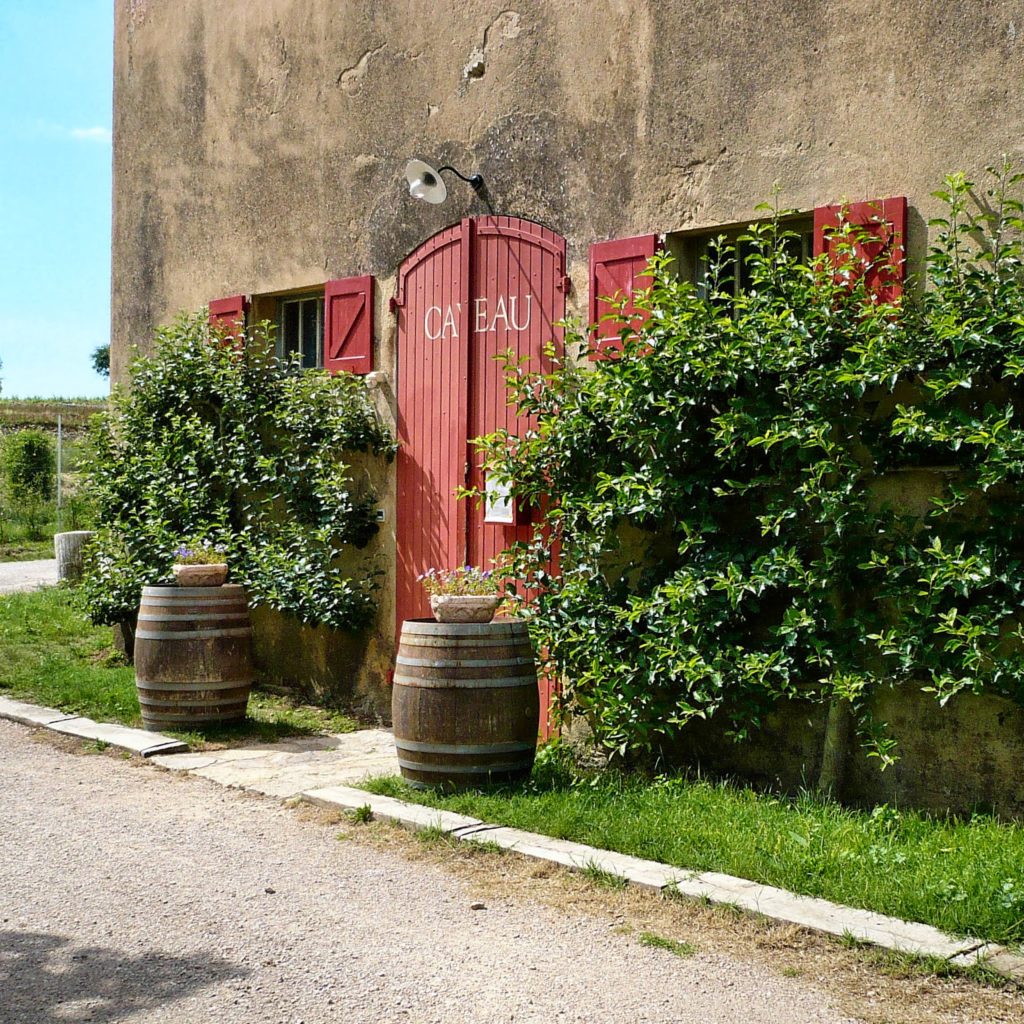
The tasting to cave at Château Miraval in 2007, prior to the Brad and Angelina acquisition. Photo by Pamela J. O’Neill
We even discovered another curiosity completely unrelated to the grapes. The sleek label, said to be designed by Jolie, has “Miraval” written around the top on bottles imported into the United States, but “Pink Floyd” is written across the top in France. One of our sources in the Var said that this difference was due to a copyright issue in the States. I don’t know and have decided to remain in a permanent state of curiosity about this one.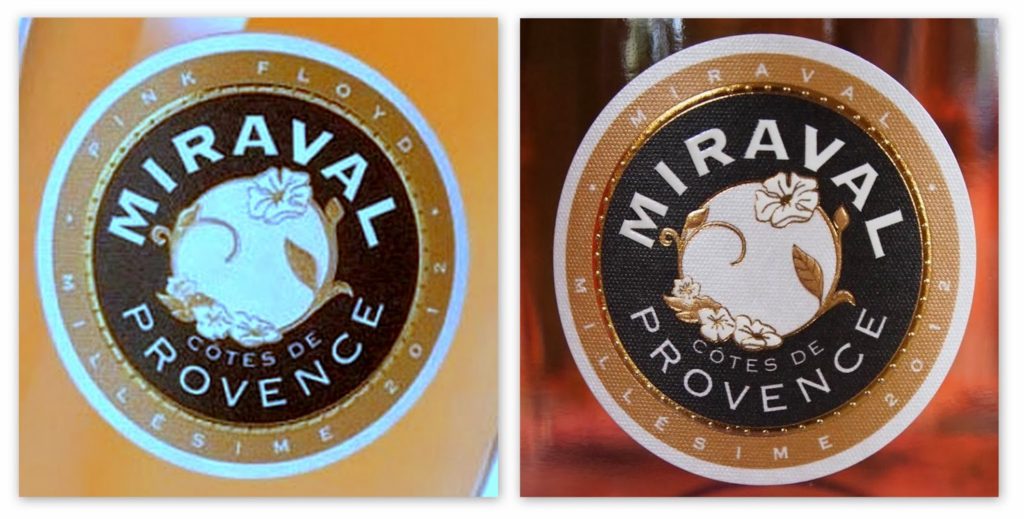 The issue about which our group of tasters is particularly curious is why didn’t the Team J-P&P just say that the 2012 Miraval rosé would not made (entirely) from organic grapes…if that is the case? Or, that the vineyards from which they received the grapes employed organic-cultivation best practices but, opted not to go through the certification process. Or, that all the grapes are organic but they opted not to put the logos on the bottle (because one can see that the diminutive label, apparently designed by Jolie, does not leave any room for any logos, however tiny, and the green colors would have clashed with the gold and navy blue colors).
The issue about which our group of tasters is particularly curious is why didn’t the Team J-P&P just say that the 2012 Miraval rosé would not made (entirely) from organic grapes…if that is the case? Or, that the vineyards from which they received the grapes employed organic-cultivation best practices but, opted not to go through the certification process. Or, that all the grapes are organic but they opted not to put the logos on the bottle (because one can see that the diminutive label, apparently designed by Jolie, does not leave any room for any logos, however tiny, and the green colors would have clashed with the gold and navy blue colors).
Although there is a growing demand for “organic wine” and the number of vineyards going “bio” is steadily growing, it is an expensive process that takes as long as four years to receive certification, and then requires yearly certification. (And, interestingly, unlike fruits and vegetables, there is no campaign to support a mark-up in price of bio wines to cover these extra efforts.)
So, many wineries engage in organic-farming best practices but aren’t certified and others, mindful of the benefits of organic cultivation but aware of the “Great French Wine Blight” due to the Phylloxera aphid, use chemicals minimal.
I remember well the first bio vineyard we visited in Provence, some fifteen years ago. It was Domaine des Terres Blanches in the small appellation, Les Baux de Provence, near Saint-Remy. The people who worked there were so excited and took such pride in showing us the plantings (interspersed in the vines) that are compatible to the vines that but repellant to insects harmful to the vines.
The proof of these good practices is in the soil, the deep roots, and ultimately in bottle, these converts say. “What goes in the grape goes in the bottle.”
We really like the 2012 Miraval rosé. We are just curious.
______________
Note: We also really, really like the 2012 Chateau Margüi rosé “Perle de Margüi” (Coteaux Varois en Provence) and will share our tasting notes on this wine in a later post. It deserves more attention than I could devote here. (Their tasting room is open Tuesday through Saturday!)
I am grateful to Pamela J. O’Neill for her research and photography

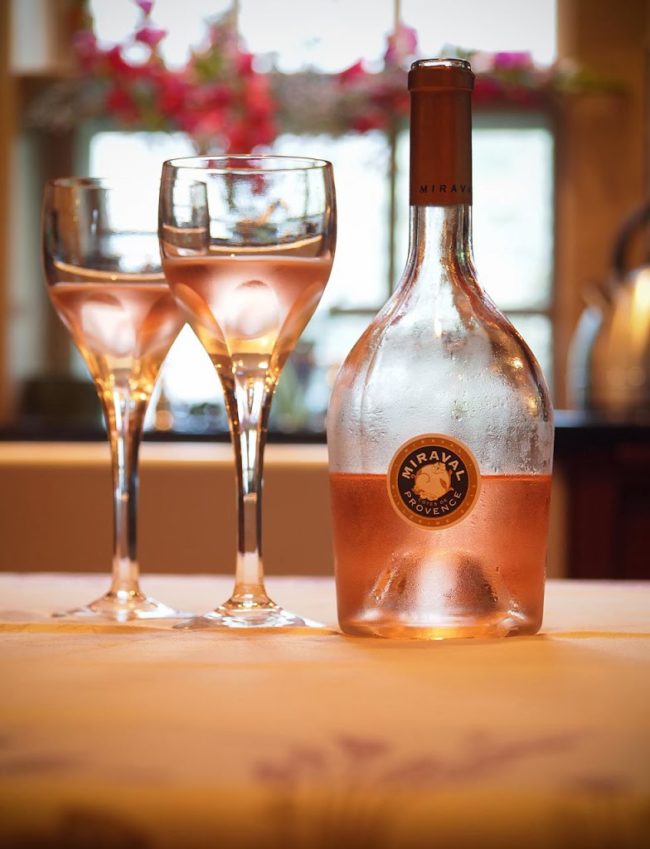
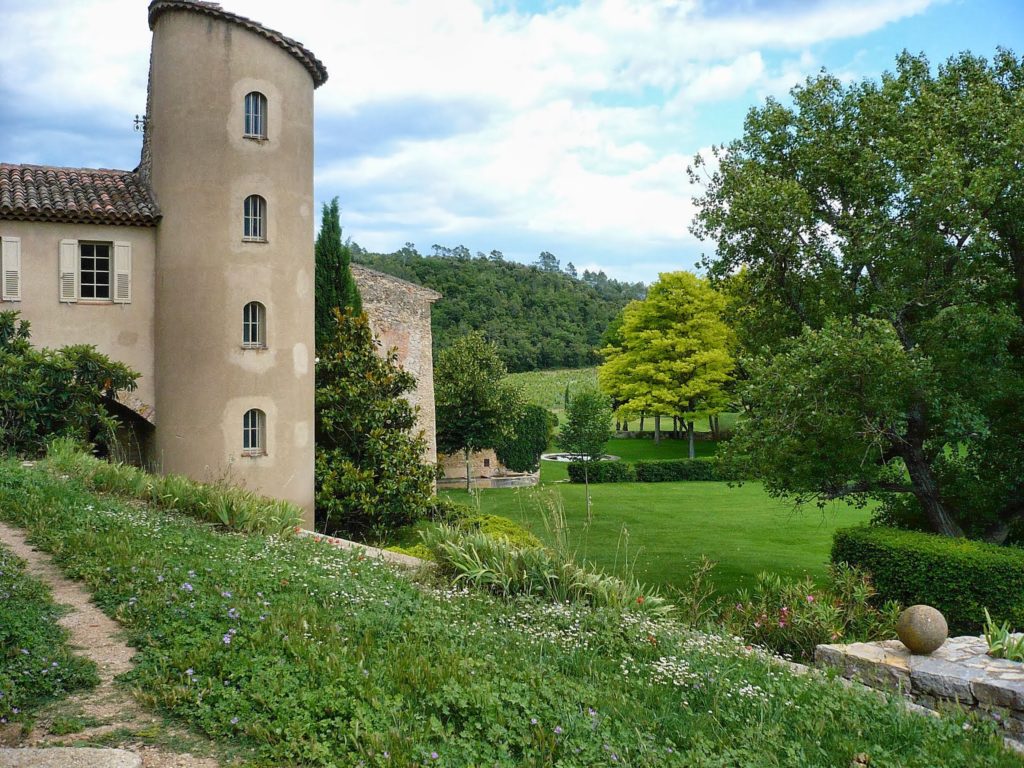
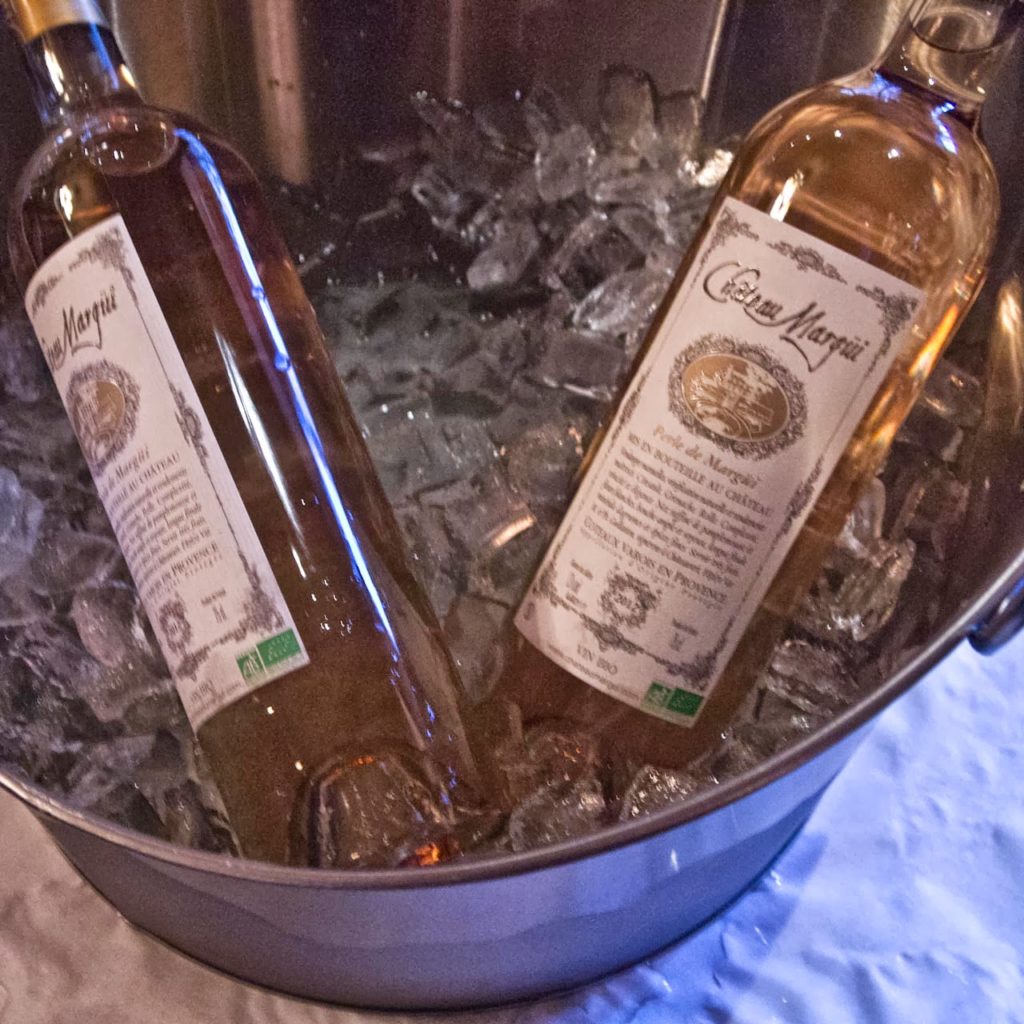
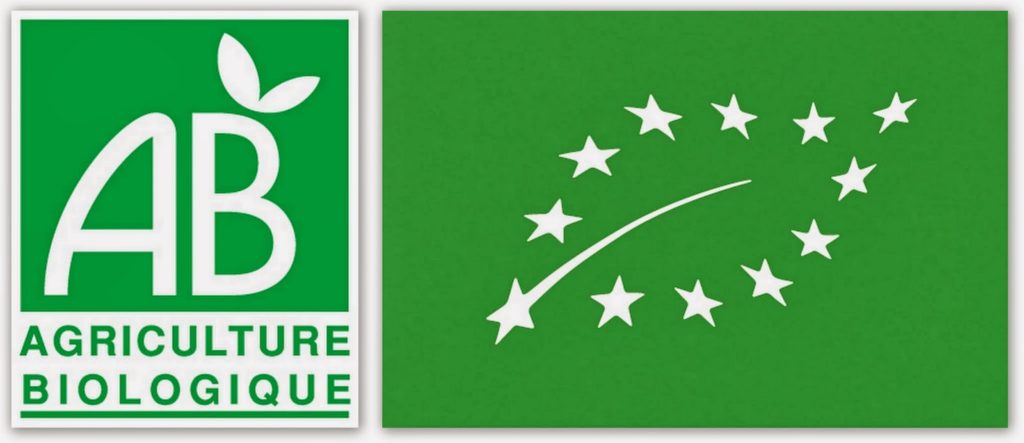
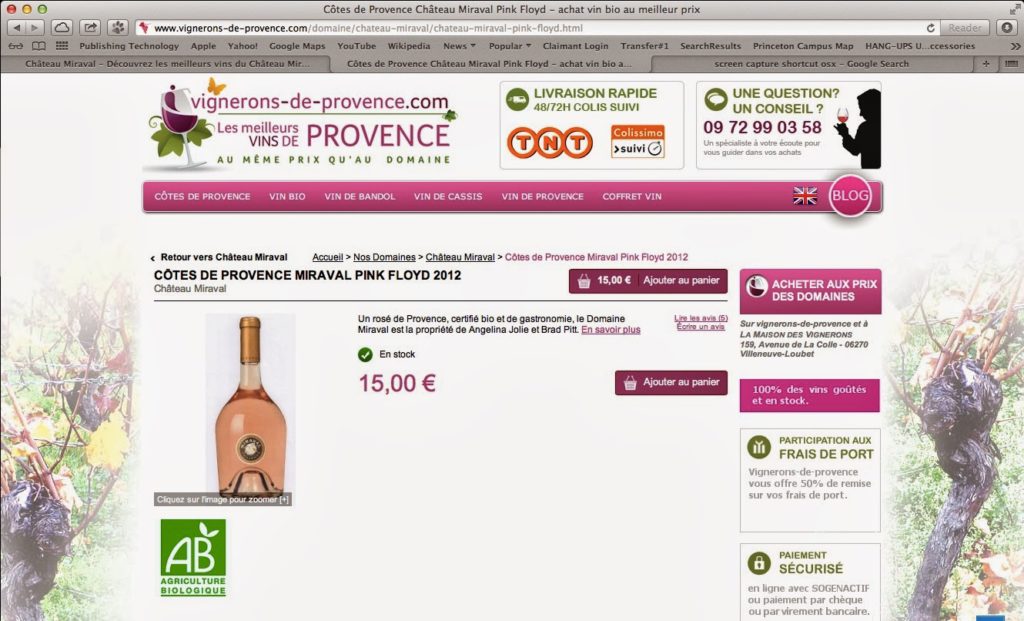
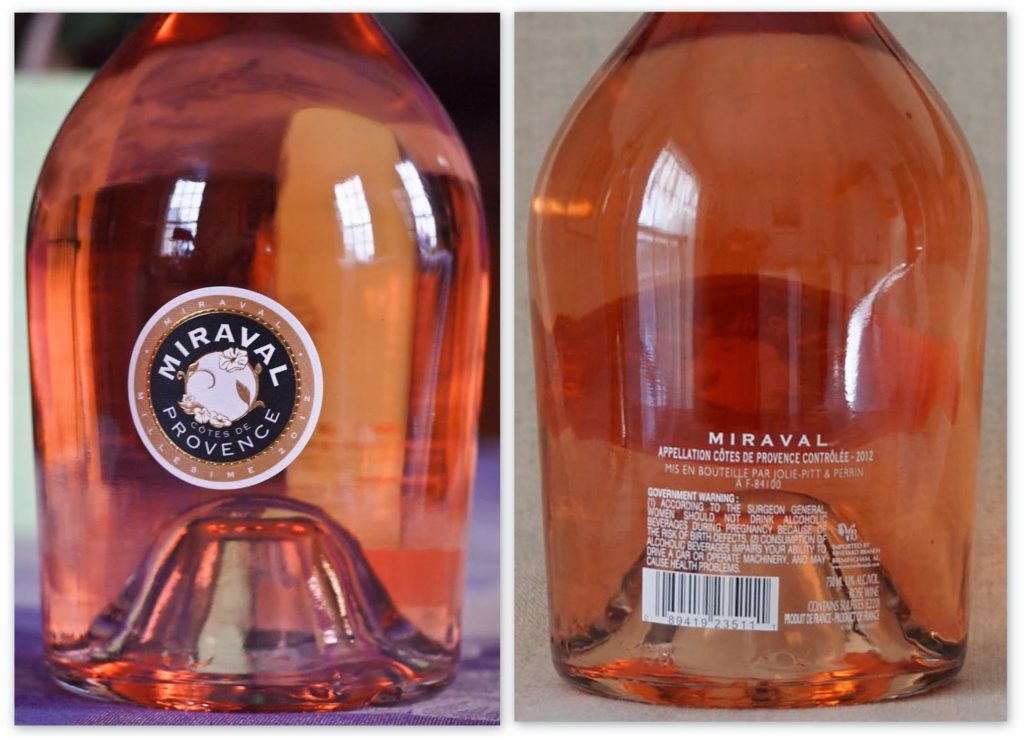
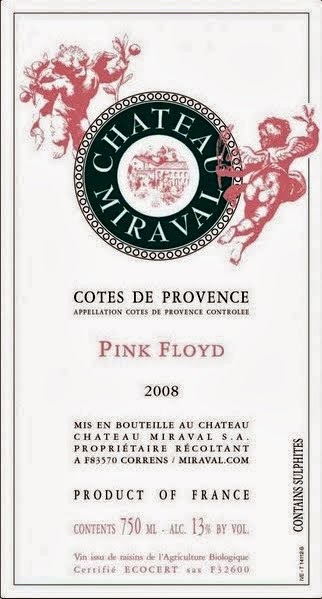

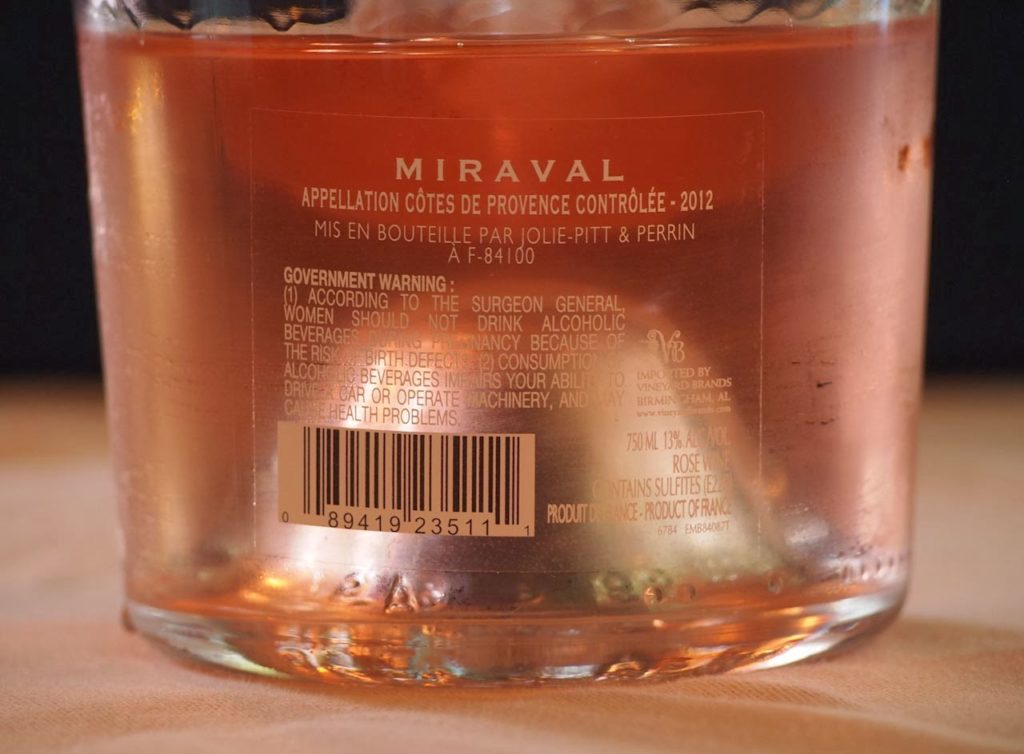
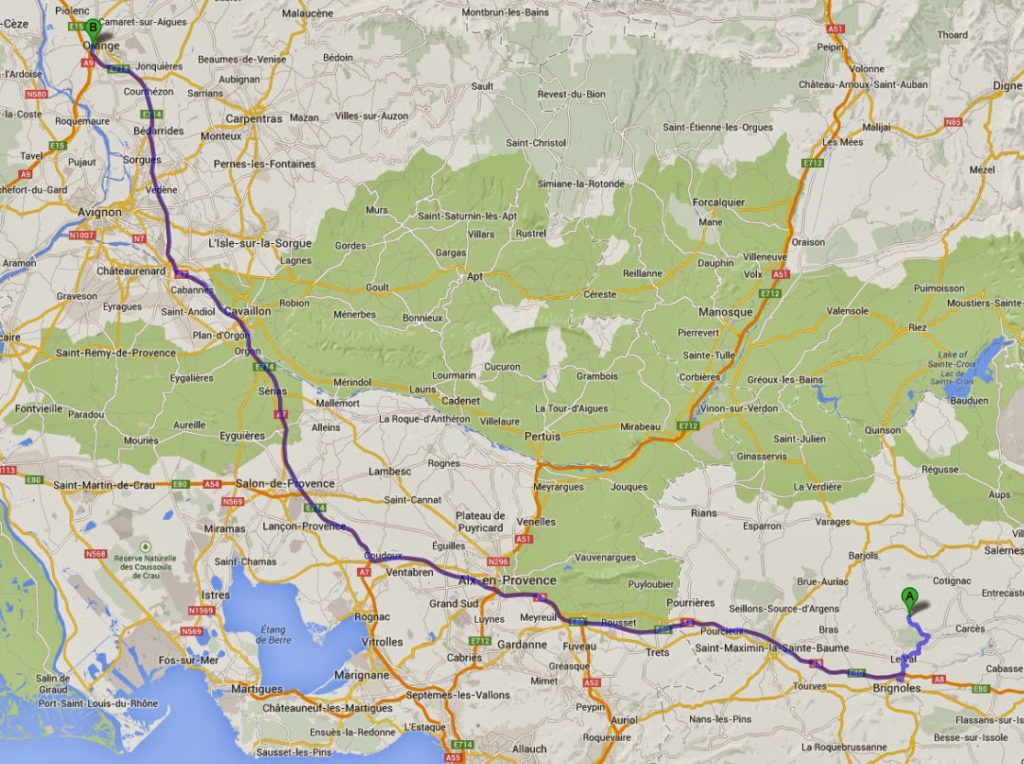
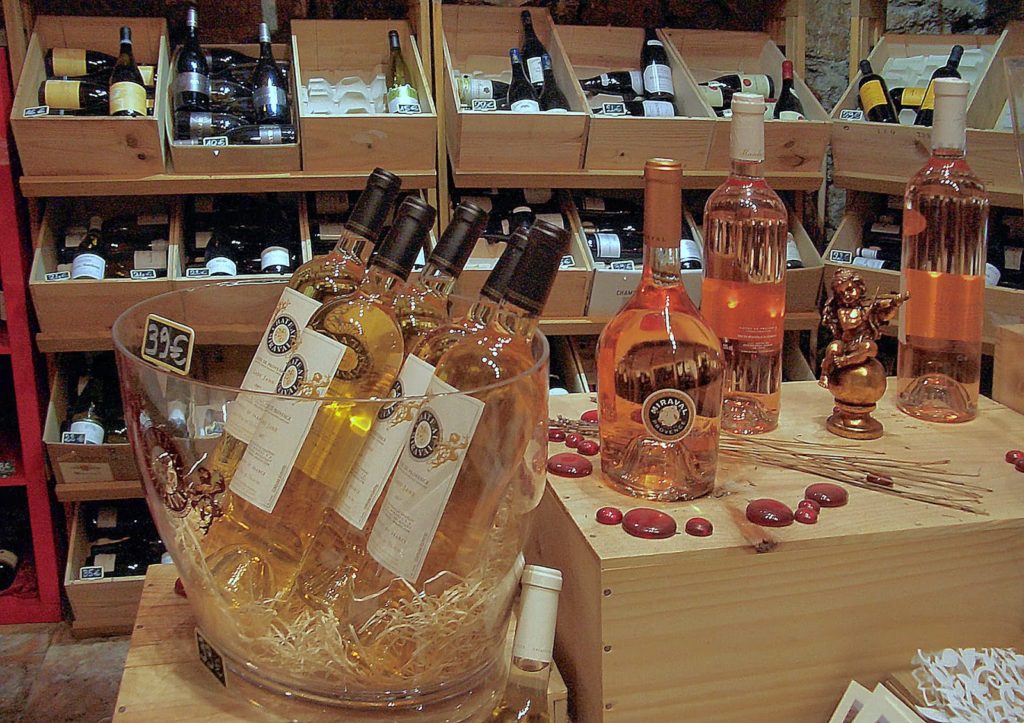
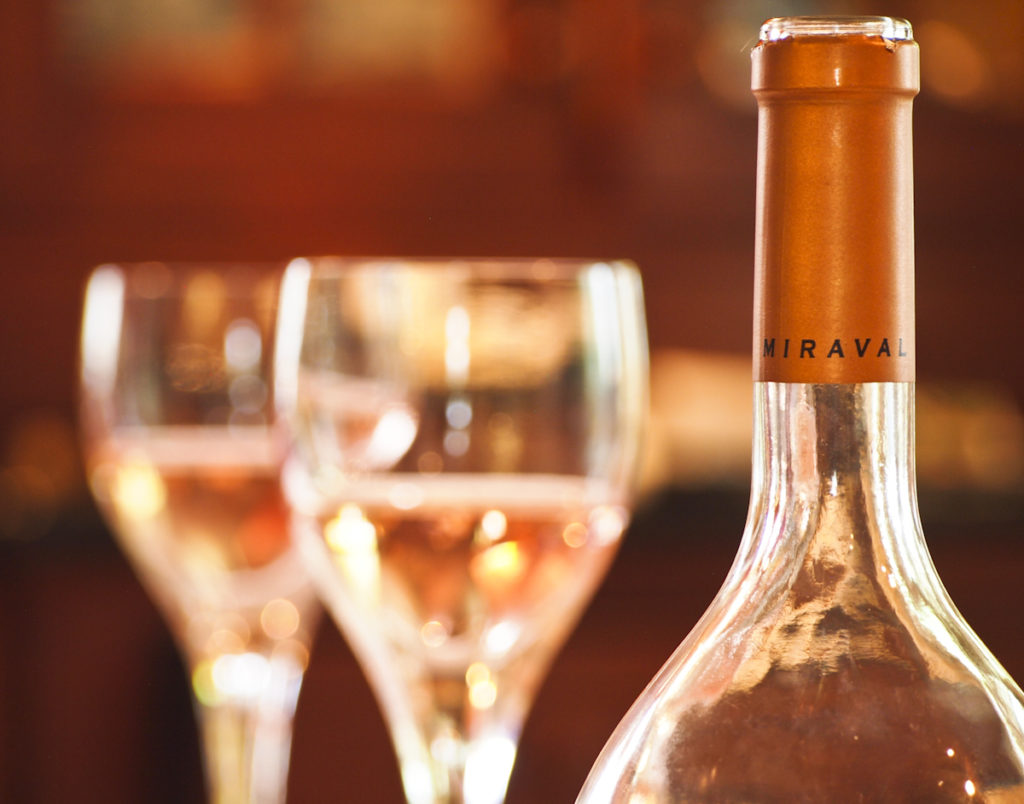
Wow, incredible sleuthing Susan…a very informative and interesting read. You may want to think about creating a tour company geared toward foodies and wine lovers adventures. Thank you as always for another amazing story. Have your aunt and uncle Barbara and Max been over to visit while you’ve been in residence? Sounds right up their alley. ;0) Denise
Thanks very much, Denise! I became curiouser and curiouser! And, no, unfortunately, we have not met up with Barbara and Max in Provence, but I have always thought we would have fun together there!
Great sleuthing, team! Keep us posted as the story unfolds!
Thanks, Kirsten. I will keep you posted but, I have a feeling that we will not get to the bottom of this caper!
Great sleuthing, team! Keep us posted as the story unfolds!
WOWZA! Susan! What a scoop! Yes, definitely keep us avid readers in the loop!
Maybe you can help me once you are over there! Thanks, Linda!
WOWZA! Susan! What a scoop! Yes, definitely keep us avid readers in the loop!
You are the Nancy Drew of Oenology! (If only little Nancy were allowed to have wine… just think of what she could do!) Loved this story – and, like you, I don’t really care one way or the other. But it is curious! ~ David
Ah, Nancy Drew…I was an avid fan and have some very old books that Alex read, too! Maybe I could start a new series for adults!
You are right about whether it is bio or not doesn’t matter as much as what happened. I always take note when a winery is “bio” because it does take more effort and more expense, but there are many wineries that employ sustainable methods that eliminate or reduce the need for pesticides but are not certified. The proof is ultimately in the bottle!
Thanks, David, for your note!
You are the Nancy Drew of Oenology! (If only little Nancy were allowed to have wine… just think of what she could do!) Loved this story – and, like you, I don't really care one way or the other. But it is curious! ~ David
Wow, incredible sleuthing Susan…a very informative and interesting read. You may want to think about creating a tour company geared toward foodies and wine lovers adventures. Thank you as always for another amazing story. Have your aunt and uncle Barbara and Max been over to visit while you've been in residence? Sounds right up their alley. ;0) Denise
Thanks very much, Denise! I became curiouser and curiouser! And, no, unfortunately, we have not met up with Barbara and Max in Provence, but I have always thought we would have fun together there!
Thanks, Kirsten. I will keep you posted but, I have a feeling that we will not get to the bottom of this caper!
Maybe you can help me once you are over there! Thanks, Linda!
Ah, Nancy Drew…I was an avid fan and have some very old books that Alex read, too! Maybe I could start a new series for adults!
You are right about whether it is bio or not doesn't matter as much as what happened. I always take note when a winery is "bio" because it does take more effort and more expense, but there are many wineries that employ sustainable methods that eliminate or reduce the need for pesticides but are not certified. The proof is ultimately in the bottle!
Thanks, David, for your note!
Curious minds want to know…but only Benjamin Button knows for sure. Will keep ear to the ground here in the Var for release of the Coteaux Varois and see what the label tells us. Kudos, Girl Snoop. Love the last photo, Towny. Très artistique.
Curious minds want to know…but only Benjamin Button knows for sure. Will keep ear to the ground here in the Var for release of the Coteaux Varois and see what the label tells us. Kudos, Girl Snoop. Love the last photo, Towny. Très artistique.
Yes Benjamin Button was on my mind as I wrote this post…I wondered who would be the first to mention him!
Yes, as No.1 roving reporter, please keep us posted on the new wines!
Yes Benjamin Button was on my mind as I wrote this post…I wondered who would be the first to mention him!
Yes, as No.1 roving reporter, please keep us posted on the new wines!
Speaking of curious…still want to know if there are trademark restrictions regarding use of the “Pink Floyd” name on the new Miraval labels in the U.S. as opposed to in France. Seems odd considering the Chateau Miraval Pink Floyd of the past was sold in the States. Do you suppose they’re going to phase out the name PF but didn’t want to alienate their French fans with first J-P-P offspring?
Speaking of curious…still want to know if there are trademark restrictions regarding use of the "Pink Floyd" name on the new Miraval labels in the U.S. as opposed to in France. Seems odd considering the Chateau Miraval Pink Floyd of the past was sold in the States. Do you suppose they're going to phase out the name PF but didn't want to alienate their French fans with first J-P-P offspring?
This comment has been removed by the author.
This comment has been removed by the author.
O.K. Susan, remember the mysterious bottle of Pink Floyd “of old” (to take a peek, go to: http://tinyurl.com/k9kso9m) we spied on an internet site? Well, my Cotignac Deep Throat has gotten to the bottom of it. There is indeed a 2012 Pink Floyd in addition to the 2012 Miraval Côtes-de-Provence rosé. A limited quantity was produced to fulfill an evidently iron-clad contract with Société des alcools du Québec, the government-owned corporation responsible for the trade of alcoholic beverages within the province of Quebec. So, no label trumpery here. It was the real thing!
O.K. Susan, remember the mysterious bottle of Pink Floyd "of old" (to take a peek, go to: http://tinyurl.com/k9kso9m) we spied on an internet site? Well, my Cotignac Deep Throat has gotten to the bottom of it. There is indeed a 2012 Pink Floyd in addition to the 2012 Miraval Côtes-de-Provence rosé. A limited quantity was produced to fulfill an evidently iron-clad contract with Société des alcools du Québec, the government-owned corporation responsible for the trade of alcoholic beverages within the province of Quebec. So, no label trumpery here. It was the real thing!
this blog was perhaps the most interesting and mouth watering story yet !As a person who prefers rose’ wine , and was once looked down their noses by those with more expertise, enjoyed a glass of wine with dinner without really thinking about it until I read the in depth dscription of the four wines. At that time I wish I could taste each one with with my newly educated taste buds and the expertise of a professional. I wish that we could have a real first class wine tasting in Southern Califotnia. Paul Chevalier would be a first choice.
I received your email indicating that this comment was meant to appear under the post about the Chateau d’Esclans tasting in NYC. So, at your request, I have copied and pasted your comment there, too!
Sounds like you were ahead of your time! I can see that there is a lot of interest in rose these days and in learning more about tasting it! In the end, what matters most is what you like…but, a professional tasting sure is informative and fun!
this blog was perhaps the most interesting and mouth watering story yet !As a person who prefers rose' wine , and was once looked down their noses by those with more expertise, enjoyed a glass of wine with dinner without really thinking about it until I read the in depth dscription of the four wines. At that time I wish I could taste each one with with my newly educated taste buds and the expertise of a professional. I wish that we could have a real first class wine tasting in Southern Califotnia. Paul Chevalier would be a first choice.
I received your email indicating that this comment was meant to appear under the post about the Chateau d'Esclans tasting in NYC. So, at your request, I have copied and pasted your comment there, too!
Sounds like you were ahead of your time! I can see that there is a lot of interest in rose these days and in learning more about tasting it! In the end, what matters most is what you like…but, a professional tasting sure is informative and fun!
Reading this one year later… 🙂 What struck me as reading this was the label graphic itself. It looks like stefana (orange blossom). Maybe they knew it would be mis en bouteille dans Orange?!?
Cheffian, My guess is you've got a "bingo!" (Noting that the Pink Floyd, in the other graphic had a picture of the chateau inside the circle, now replaced with a circle/Orange). I don't know why folks aren't more straightforward, the truth usually comes out. That it wasn't bio would have been understood, but a potentially deliberate lack of clarity in the marketing not so much… very hard to repair trust. A smudge on such a pretty bottle…
Who knew reading about sleuthing on the subject of a bottle of rose' label would be such a fun and interesting read? But it was! Great job Susan! I really enjoyed this story! 🙂